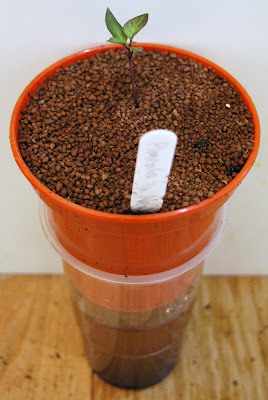This week I have some time off so I have started to re-pot some of the seedlings I have growing in peat disks. I don't know how big plants can get in these without getting stunted, so will err on the side of caution.
I have picked the largest five to pot on (well the largest 4 plus "Pimenta de neyde" because it was getting leggy).
The plants I potted were: Pimenta de Neyde, Aji jobito, Habanero Hawaii beach, 7pot Bubblegum and not pictured here My own F2. All had roots coming through the sides and base, so I guess were ready to be potted. They went into my standard self watering pots so will not need to be re-potted again until spring. I top all pots off with a light volcanic substrate made for aquariums to seal in moisture and help provide a barrier to fungus gnats.
The first plant needing to be potted was an annuum. I have not planted many annuum seeds yet because they grow fast and can quickly outgrow my space. However I could not resist planting at least one of my F2 own creation. the F1 was a cross between a Hungarian black with something larger and look forward to seeing the variation in the F2 plants. I planted a seed just too see what the seed viability would be like. Things look good as the seed germinated quickly and has grown quickly. Another good sign is the purple colouring in the plants cotyledons, this usually shows the plant will have purple colouring in its flowers and peppers.
F2 My own chill
The next plant I decided to pot was my Pimenta de Neyde. This was one of the smaller seedlings but had grown overly tall so would benefit going into a pot so it could be earthed up (although looking at it now I should have planted it deeper). I love the colour already showing on the leaves of this plant, it should be a great plant for crossing with in the future.
Pimenta de Neyde
The third plant I potted was one of the chinense I am most looking forward to growing Aji jobito. This is meant to be one of the best tasting low/no heat chinense varieties. Interestingly this plants seems to have split growing tip on its first set of leaves.
Aji jobito
The last two seedlings I potted just happened to be the next biggest seedlings. 7pot Bubblegum is probably the hottest variety I am growing this season but what i am really growing it for is its trait of having a coloured calyx on its fruit. the other seedling was Habanero Hawaii beach, a large red habanero I got free seeds for.
7pot Bubblegum
Habanero Hawaii beach
I also started off some more seeds. Mostly more wild peppers but also some first sowings of pepper relatives.
Capsicum rhomboideum x 1 - already got one growing well, started a second.
Capsicum galapagoense x 2 first sowing not germinated yet so started two more.
Capsicum lanceolatum x 2 first sowing not germinated yet so started two more.
Capsicum eximium x 1 - already got one growing well, started a second.
Capsicum cardenasii x 2 just recieved these seeds so started off two.
Capsicum chinense x annuum Pimenta de Neyde x 1 already have one but like the plant so much I started a second.
Solonum uporo x 2 first experimental sowing of these. The "Cannibals tomato" is plant I am looking foreward to studying. it is probably too early to start these off as these grow like an eggplant/aubergine so may get too large with my space restrictions, but we will see.
Solonum topiro/sessiliflorum x 2 first experimental sowing of these. The "Cocona" is tropical plant so will probably stay indoors as a houseplant.
Solanum quitoense x 2 first experimental sowing of these. The "Naranjilla" is tropical plant so will probably stay indoors as a houseplant.
Solonum albutiloides x 2 first experimental sowing of these. "Dwarf Tamarillo"
lycium chinense x 2 first experimental sowing of these. Either "goji" or "wolfberry" there are two species that seem to be interchangeable. I will try to find seeds for the other and check out both.
That is all for today, I will leave you with a photo of two of my wild seedlings.






















































